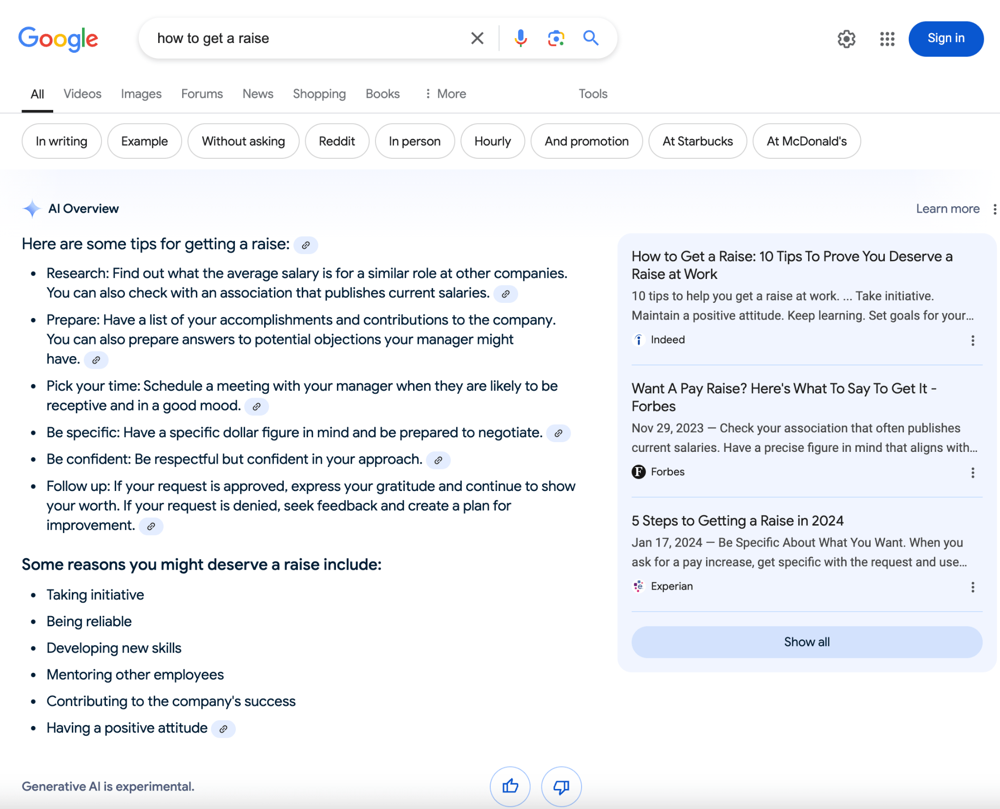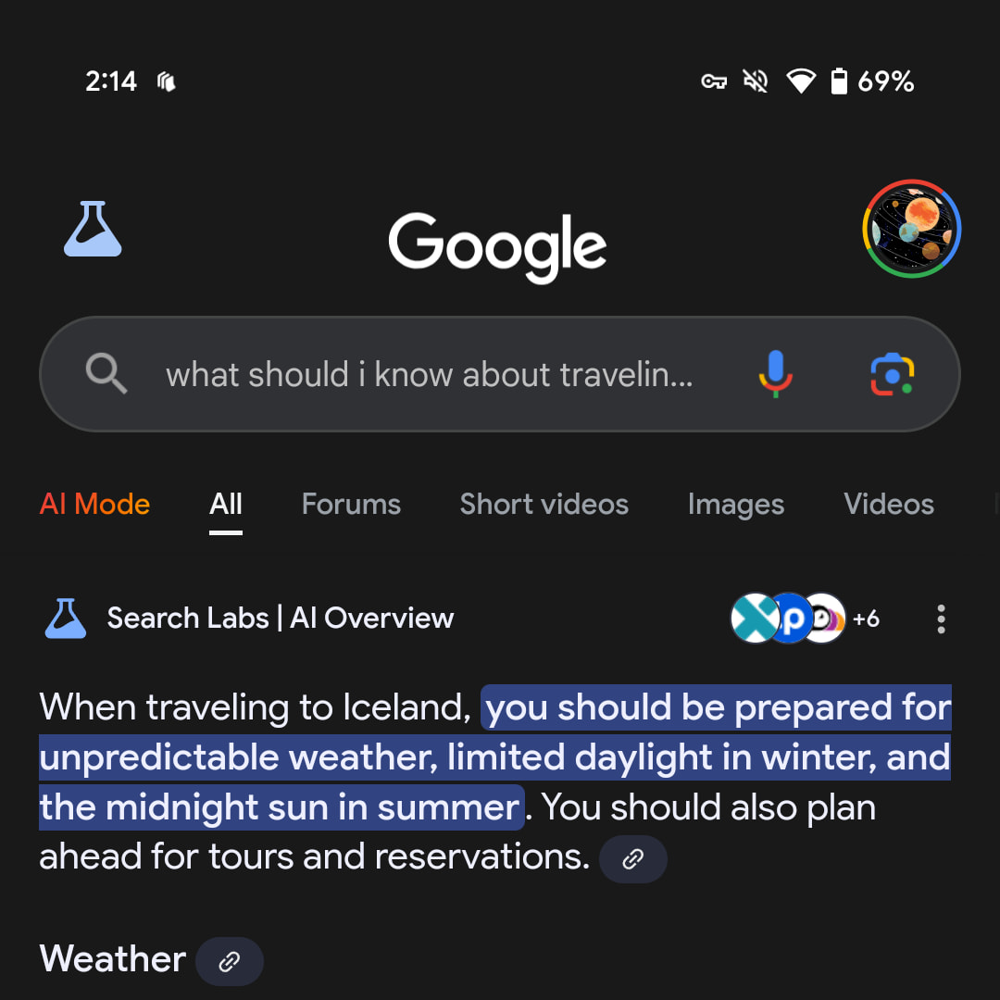
Google’s AI Overviews vs. AI Mode: What Marketers Need to Know
Google Search is evolving with new AI-driven features that change how users find information. Two key innovations are AI Overviews and the newly announced AI Mode. In this post, we’ll break down what each feature does, who can use them, and where they’re available. We’ll also explore what these changes mean for the future of search – and how digital marketers can adapt in terms of SEO and search advertising (SEA).
AI Overviews: Snapshot Answers in Search
What it is: AI Overviews are AI-generated summaries that appear at the top of Google’s search results for certain queries. Think of them as enhanced featured snippets “on steroids” – quick overviews of a topic with key information drawn from various sources, including the web and Google’s Knowledge Graph. An AI Overview might include a brief paragraph or bulleted list of insights, and always provides cited links so users can “dig deeper” into the sources.
What it’s used for: AI Overviews help users quickly grasp a topic or answer without manually piecing together info from multiple websites. For example, a query like “how to get a raise” might return an AI Overview listing tips (research your market value, prepare accomplishments, pick the right timing, etc.) along with links to articles from sources like Indeed or Forbes. This gives searchers an immediate answer outline, plus pathways to read more detail on those sites.

Where it’s available: Google initially tested AI Overviews in Search Labs (as part of the Search Generative Experience, or SGE) in 2023. In May 2024, AI Overviews rolled out to all users in the U.S., with expansions to other countries soon after. By late 2024, it had launched in at least six more markets – including the UK, India (English and Hindi), Japan, Indonesia, Mexico, and Brazil. Today, AI Overviews are widely accessible (no sign-in required) to hundreds of millions of users, and over a billion people have tried them so far. Notably, Google recently enabled AI Overviews for teens under 18 as well, indicating a broad public rollout.
Who can access: Everyone in supported regions can see AI Overviews on Google Search. There’s no special sign-up anymore – if your query triggers an AI Overview and you’re in a country/language where the feature is live, it will appear automatically. Publishers don’t need to do anything special for their content to be included; Google’s systems decide when an overview is useful and which web sources to cite.
AI Mode: Google’s New Conversational Search Experiment
What it is: AI Mode is an experimental search mode that Google introduced in March 2025 for more advanced, interactive queries. Unlike the one-shot summary of an AI Overview, AI Mode turns Search into a chat-like experience. It uses a custom version of Google’s latest AI model (Gemini 2.0) to provide deeper reasoning, multi-step thinking, and even multimodal answers (text with images, etc.). In AI Mode, you can ask complex or open-ended questions and get an AI-generated response that’s more comprehensive, with the ability to ask follow-up questions in context.
What it’s used for: AI Mode is designed for those tough or multi-part searches where you’d normally need to perform several queries and comparisons yourself. Google calls it helpful for queries “where further exploration, reasoning, or comparisons are needed”. For example, you might ask “What’s the difference in sleep tracking features between a smart ring, a smartwatch, and a sleep tracking mat?” – a nuanced comparison that AI Mode can tackle by breaking the task into sub-queries, gathering up-to-date info on each option, and synthesizing it into a clear comparison. You could then follow up with, “How does deep sleep affect heart rate?”, and the AI will remember the context (sleep tracking) and provide a detailed answer with relevant links. Essentially, AI Mode acts like a research assistant, doing the legwork across the web and giving you a consolidated answer, built right into Search.

Screenshot of Google’s mobile Search interface showing the new AI Mode tab (left of “All”) and an AI-generated result. Users can tap the AI Mode tab or go to google.com/aimode to enter the conversational search experience.
Where it’s available: As of early 2025, AI Mode is in limited testing through Google’s Search Labs. It’s currently an opt-in beta in the U.S. (for English queries) and appears as a separate “AI Mode” tab on the Google Search page or app for those who have access. Google is starting small – initially inviting Google One Premium subscribers (those paying for the AI-enhanced plan) to try it first. In late March 2025, Google began expanding AI Mode via a waitlist, letting some non-subscribers in the U.S. get access as well. For now, it’s very much an experiment: you’ll only see AI Mode if you’ve opted into the Labs experiment and been granted access. Broader public rollout will depend on testing feedback.
Who can access: A small group of users can access AI Mode at the moment. If you’re a Google One Premium (AI tier) subscriber, you likely got an invite in early March 2025. Other users can join a waitlist in Search Labs (on labs.google.com or the Google app) and are gradually being let in. It’s U.S.-only for now, and you need a Google account to opt in. Marketers should note that this is an early look at a potential future feature – not yet available to the general public. Google itself calls it an “early experiment” and will refine it with tester feedback before any wider release.
Key Differences Between AI Overviews and AI Mode
- Format and Interaction: AI Overviews are integrated into the standard search results page as a static snapshot answer (with source links) for a given query. AI Mode, on the other hand, is a separate mode that offers a dynamic Q&A interface – essentially turning search into a conversation where you can ask follow-ups and get iterative results.
- Use Cases: AI Overviews handle everyday informational queries where a quick summary is helpful (“overview” type questions). AI Mode is geared toward complex, exploratory tasks – planning, problem-solving, or research questions that benefit from AI’s reasoning and the ability to refine the query. If an AI Overview is like an instant answer box, AI Mode is like chatting with a very knowledgeable assistant within Google.
- Availability: AI Overviews are widely available now to regular search users in supported locales, as part of the core search experience. In contrast, AI Mode is limited to Lab testers at this stage. It lives behind an “AI Mode” filter/tab that only appears for those in the experiment. So most users won’t see AI Mode yet.
- Technical Capability: Both leverage Google’s generative AI (Gemini models), but AI Mode uses a more powerful, custom version with advanced reasoning and “multimodal” input/output (meaning it can incorporate images, etc.). AI Overviews are already quite advanced (Google recently upgraded them with Gemini 2.0 in the U.S. to improve handling of coding queries, math problems, and visual queries), but AI Mode pushes further by orchestrating multiple searches behind the scenes (“query fan-out”) to gather deeper information. In short: AI Overviews give you a concise answer drawn from one round of AI analysis, whereas AI Mode can dig through several layers of information in a single session for a more comprehensive response.
- Access Requirements: Anyone can trigger an AI Overview (no login needed now). AI Mode requires an opt-in (and currently, an invite). Google One subscribers got first dibs, signaling that Google might offer premium AI features to paying users. However, Google is already opening AI Mode to some free users via waitlist, so it’s likely aiming for a broader user base after testing.
Now that we understand each feature, let’s look at what these changes mean for the future of Google Search and how they might impact digital marketing, from SEO to PPC.
The Changing Search Experience (and Why It Matters)
Google’s incorporation of AI is transforming search from a “find results and click links” model to a more conversational and context-driven experience. Users are starting to search in more natural language and expect the engine to do more of the heavy lifting. Instead of typing a few keywords and manually comparing results, people can ask full questions or even multiple questions in one go – and get a synthesized answer. This trend started with voice search and featured snippets, but AI Overviews and AI Mode accelerate it.
For example, a user might move from a terse query like “marketing agencies” to a longer query such as “I need a PPC marketing agency with proven results,” followed by “show me some of their case studies.” This is a huge shift in behavior. Marketers should anticipate more long-tail, conversational queries driving traffic, and ensure their content and keyword strategies align with the questions people actually ask.
Another change is the richer format of results. Google’s AI responses can include bullet points, images, product carousels, and more. Multi-step tasks (like planning a trip or troubleshooting a tech issue) might be handled in one AI-driven session rather than several separate searches. This streamlined journey means users might get to their answer or decision faster. It also means the traditional “10 blue links” are not always the first thing a user sees – they might see an overview, and only scroll to organic results or ads if they need more. In short, Google is becoming an answer engine, not just an index of links.
Implications for SEO (Organic Search)
Every time Google changes its search interface, SEOs wonder how it will affect website traffic. The good news is that Google is explicitly designing AI Overviews to drive users to click through to sources when they want more detail. In fact, Google reported that the links in AI Overviews get more clicks on average than if the same page had ranked as a regular result for that query. This suggests that being featured in an AI Overview can boost your visibility and traffic. Additionally, AI Overviews seem to make users explore a broader range of sites (not just the top one or two results) for complex questions. So there’s an opportunity for publishers: if your content is relevant and high-quality, you might gain exposure via AI summaries even if you’re not rank #1.
However, there are also challenges and unknowns. If an AI Overview fully satisfies a simple query (like a factual question), users might not click any result at all – similar to what happened with featured snippets or knowledge panel answers in the past. This could reduce traffic for queries where users just needed a quick answer. For more involved queries, users may still click, but they might click one of the suggested links in the overview rather than scrolling through all organic listings. This makes it important to be one of those suggested sources. In practical terms, that means continuing to follow SEO best practices: create authoritative, well-structured content that directly addresses common user questions. Schema or structured data can’t directly “opt you into” AI Overviews, but content that is clear, factual, and easy for algorithms to parse has a better chance of being included.
Marketers should also track their search performance data in new ways. Google has indicated that impressions and clicks from AI Overview links are counted in Search Console performance reports just like regular results. It might not yet break out “AI Overview” as a separate category, but stay tuned for possible new metrics. Keep an eye on engagement metrics too – if users spend less time bouncing between sites because they got what they needed faster, how does that affect your on-site strategy? Perhaps providing depth and unique insights (the stuff an overview might gloss over) will be key to converting those who do click through.
In summary, SEO is not dead – but it’s evolving. Traditional ranking is still critical, because if Google’s AI doesn’t find your site relevant, you won’t be part of the overview or the results. But now there’s an added layer: optimizing for answer visibility. Focus on user intent and questions. Consider adding concise Q&A sections or summaries in your content (which might be snippeted by the AI) followed by richer detail for those who click in. And continue to build credibility (E-E-A-T: Experience, Expertise, Authoritativeness, Trustworthiness), since Google’s systems will favor reliable sources when assembling AI answers.
Implications for SEA (Ads and PPC)
Search advertising will also be affected by these AI features, though Google is treading carefully to balance user experience and ad revenue. Currently, ads do appear alongside AI Overviews, but the format is evolving. Early tests showed that for many commercial queries, Google would still show sponsored results – sometimes above the AI Overview, sometimes below, and even occasionally inline within the AI answer box (clearly labeled as “Sponsored”). For example, a shopping query might trigger a product carousel ad at the top of the page, even if an AI summary is present. Google’s ad team has noted that SGE (now AI Overviews) is creating “new opportunities… by showing relevant ads alongside search results”. In other words, Google isn’t removing ads; it’s integrating them in new ways.
For marketers running PPC campaigns, this means you need to monitor changes in ad placement and performance. It’s possible that top-of-funnel, informational queries (where a user might just read the AI Overview and not click an ad immediately) could see lower ad click-through rates. On the other hand, highly commercial queries (where the user intent is to buy or compare products) might still show prominent ads, or the AI Overview might actually incorporate product info that leads into an ad. Google has indicated that if a query is very commerce-focused, it may choose to show a traditional results page with ads instead of an AI overview, or use the AI to highlight things like pricing and reviews along with shopping links. The exact behavior will likely continue to be adjusted.
Key considerations for PPC:
- Shifts in Query Patterns: As mentioned, people are using more conversational queries. This could impact keyword targeting – expect more long-tail search terms and question-based queries. Your keyword strategy should account for these (e.g. consider adding question phrases or using broad match with smart bidding to capture them). Also, your ad copy might need to align with more specific intents (“looking for X with Y feature?”) as queries get more detailed.
- Ad Position and Format: Be aware that your ad might show below an AI block rather than at the very top. This could affect visibility. Keep an eye on metrics like average position (if Google provides them for AI-integrated results) and click-through rate. Google may introduce new formats – for instance, an ad could appear as one of the “links” in an overview or a sponsored suggestion. Ensure your ad messaging is compelling enough to compete in that context. Also, utilizing ad extensions (like images, prices, etc.) could make your ads more noticeable if they appear below an AI answer.
- Performance Tracking: Watch for changes in impression share and conversion rates on queries that likely have AI overviews. You might find fewer impressions for some broad informational queries if users don’t scroll as much. Conversely, if AI Overviews encourage more searching overall (Google claimed people use search more with them), there may be more total opportunities to capture users at later stages of their journey. It’s a bit early to tell, so maintain a flexible budget and be ready to adjust bids.
- Top vs Bottom Funnel: Some experts predict that AI Overviews will mostly impact upper-funnel activity – where the user is just learning or comparing (and might lean on the AI summary) – while lower-funnel intent (specific searches like “buy X online”) will remain similar to before. In practical terms, your awareness campaigns might see the biggest shifts, whereas conversion-focused campaigns for high-intent keywords might not change as dramatically. Align your expectations and KPIs accordingly.
Adapting Your Marketing Strategy
Both AI Overviews and AI Mode point toward a future where Google Search is more interactive and “smart.” Marketers should keep a few things in mind moving forward:
- Stay Informed: These features are evolving quickly. Follow Google’s announcements and industry analyses. The fact that Google is testing AI Mode with power users indicates they’re gathering feedback before a wider launch. It’s a hint that more conversational search could become mainstream. Being aware early gives you a head start to adapt content and campaigns.
- Focus on Quality Content: This has always been true, but as AI takes a greater role in curating what users see, quality is paramount. Google’s systems for AI results still rely on core ranking signals and content quality measures. Ensure your site has clear, factual, and useful information. If AI summarizers are essentially reading and paraphrasing content from the web, you want to be the site that provides the answer it can’t ignore. High E-E-A-T content is more likely to be trusted and used by the AI.
- Optimize for Questions and Context: Consider the common questions in your niche and provide thorough answers on your site. Use natural language in your headings (think FAQ pages, how-to guides, and in-depth articles). This increases the chance that Google’s AI might pull from your text when constructing an overview. Also, provide context and examples in your content – AI Mode might be looking for nuanced info to answer follow-up questions.
- Technical SEO & Schema: While there’s no special markup to get into an AI Overview, continuing good SEO practices helps. Make sure your content is crawlable and well-structured (proper headings, lists, etc. which the AI can easily parse). Implement schema where relevant (like FAQ or HowTo schema) – these won’t guarantee inclusion, but they give Google structured data that could feed into rich results or even AI answers. Also ensure you’re not blocking content from being used in “previews” if you want to appear in AI results (the same content preview controls for featured snippets apply to AI Overviews).
- Monitor Traffic and Rankings Differently: Start looking at not just whether you rank, but how Google displays your content. If you notice a page gets impressions via an AI Overview (you might see spikes in clicks with lower average position, for instance), analyze that content. It might be satisfying certain queries well. Learn from it to optimize other pages. Google may provide more detailed analytics for AI interactions in the future – be ready to incorporate those into your SEO reporting.
- Rethink Your Ad Copy and Keywords: For advertisers, it’s time to revisit your keyword research with an AI lens. Tools and Google’s own Search Terms report may start showing more conversational queries. Embrace those in your campaigns. Also, craft ad copy that can complement an AI answer. For example, if the AI Overview gives a generic summary, your ad could offer a compelling next step (“Compare 5 Top Solutions on Our Site” or “Get a personalized quote in 2 minutes”) to entice a click. In other words, consider what the AI is answering and find the gap your ad or content can fill.
- Experiment and Gather Data: If you have access to AI Mode (or know someone who does), play with it. See how it presents information from different sites. Even if you don’t, keep an eye on case studies or reports from those early testers. The more you understand how Google’s AI chooses and displays content, the better you can position your marketing efforts. Also, test how your pages appear in AI Overviews by trying relevant queries (in markets where it’s live). It can be insightful to see which competitors are being cited and why.
- Keep User Experience First: It’s easy to get caught up in optimizing for algorithms, but remember Google’s aim with these features is to help users. If you align your strategy with improving user experience – fast answers, credible info, easy paths to deeper content or conversion – you’ll naturally be in a good place. Google’s AI advancements are trying to mimic a helpful human assistant; as a marketer, think about how your online presence can be the most helpful to your audience, and the AI will be more likely to highlight you.
Looking Ahead
Google’s AI Overviews and AI Mode experiments show that search is heading towards a more AI-powered future. For users, this promises faster, more intuitive answers. For marketers, it means adapting SEO and PPC tactics to new formats and user behaviors. The core principles remain: provide value, be relevant, and stay agile. Google is still committed to driving people to content on the web – it’s just using AI to bridge the gap between a question and the right answer more efficiently.
As these AI features expand, marketers who embrace the change – by optimizing for both human and AI understanding – will find new opportunities. Whether it’s securing a spot as a cited source in an AI Overview, or adjusting ad strategies for conversational queries, those who stay informed and experiment will thrive in the next evolution of search. The search landscape is changing, but one thing stays the same: the goal is to connect with your audience. Google’s new AI tools are simply rewriting the rules on how that connection happens. It’s an exciting time to be in digital marketing – so keep learning, keep testing, and get ready for the AI-augmented search era.
Sources:
- Google Blog – “Expanding AI Overviews and introducing AI Mode” (March 5, 2025) (Expanding AI Overviews and introducing AI Mode) (Expanding AI Overviews and introducing AI Mode)
- Google Blog – “Generative AI in Search: Let Google do the searching for you” (May 2024) (Google I/O 2024: New generative AI experiences in Search) (Google I/O 2024: New generative AI experiences in Search)
- Google Search Central – “AI Overviews and your website” (July 2023) (AI Overviews and Your Website | Google Search Central | Documentation | Google for Developers) (AI Overviews and Your Website | Google Search Central | Documentation | Google for Developers)
- 9to5Google – “Google expands Search AI Mode access to free users on waitlist” (Google expands Search AI Mode access to free users on waitlist ) (Google expands Search AI Mode access to free users on waitlist )
- Search Engine Land – “Google AI Mode rolling out to second batch of users now” (Google AI Mode rolling out to second batch of users now) (Google AI Mode rolling out to second batch of users now)
- NoGood – “Navigating AI Overviews: The Impact on Search Ads and PPC” (Navigating AI Overviews: The Impact on Search Ads and PPC) (Navigating AI Overviews: The Impact on Search Ads and PPC)
- Ahrefs – “Google AI Overviews (Formerly Google SGE): All You Need to Know” (Google AI Overviews (Formerly Google SGE): All You Need to Know)


